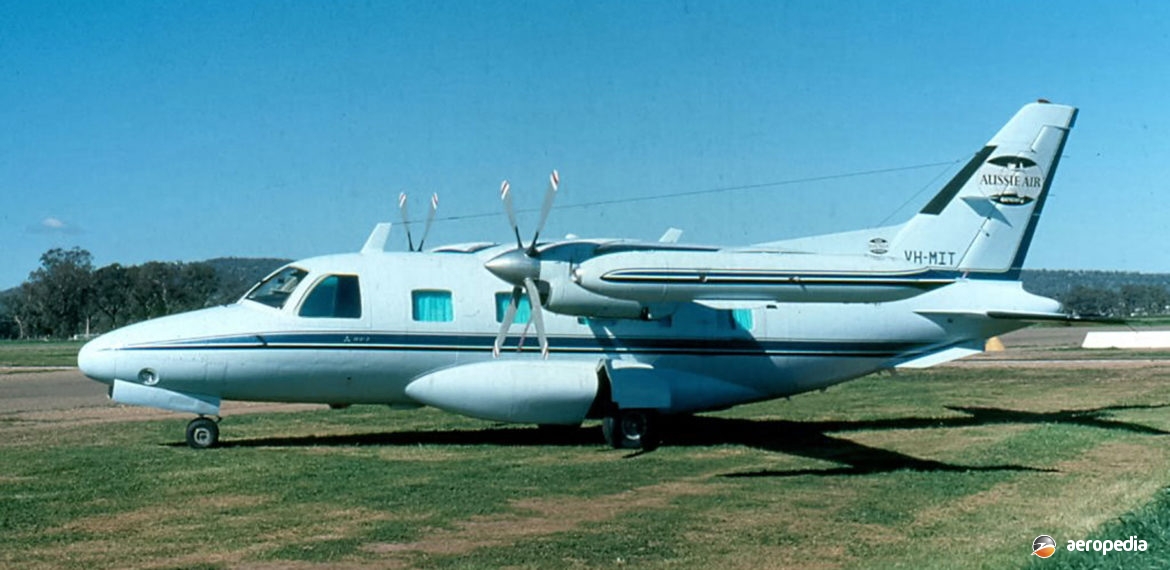Photograph:
Mitsubishi MU-2B-36A VH-MIT (c/n 720SA) at Gunnedah, NSW in August 1981 (David C Eyre)
Country of origin:
Japan
Description:
Business and executive aircraft / utility transport
Power Plant:
Two 429 kw (575 eshp) Garrett AiResearch TPE-331-25A turboprops
Specifications:
- Wingspan: 11.94 m (39 ft 2 in)
- Length: 10.13 m (33 ft 3 in)
- Height: 3.94 m (12 ft 11 in)
- Wing area: 16.54 m² (178 sq ft)
- Max cruising speed at 3,048 m (10,000 ft): 499 km/h (310 mph)
- Economical cruising speed at 6,096 m (20,000 ft): 439 km/h (273 mph)
- Initial rate of climb: 677 m/min (2,220 ft/min)
- Service ceiling: 7,925 m (26,000 ft)
- Max range with 30 mins reserve at 6,096 m (20,000 ft): 1,931 km (1,200 miles)
- Empty weight: 2,422 kg (5,340 lb)
- Loaded weight: 4,051 kg (8,930 lb)
History:
The first design of the famous Mitsubishi company to enter production (in notable quantity) after the completion of hostilities in World War II, the MU-2 was designed as a general-purpose light transport which could be used by military operators, as a small airliner, for cargo, or as an executive transport. The ability to operate the aircraft from small unpaved fields was considered to be important by the designers.
More than 800 examples of the series were built. The prototype, powered by Turbomeca Aztazou turboprops, was flown for the first time on 14 September 1963, and this model was known as the MU-2A. The first production machine was the MU-2B, powered by Garrett AiResearch engines, the first aircraft of this model being flown for the first time on 11 March 1965. Initial production variants had accommodation for seven passengers and a crew of two, and the same overall dimensions. Development of the design to meet customer requirements of operators led to model number changes, and up-rated engines, changes in the design role, and increases in gross weight. Models designed for the executive role included the MU-2B, MU-2D, MU-2F, MU-2K, MU-2M, and MU-2P.
In 1969 a variant with a longer fuselage was offered. The prototype of this model, the MU-2G, made its first flight on 10 January 1970. Accommodation was increased to nine passengers with a crew of two, and this was followed into production by the MU-2J and MU-2N. All these models were of similar dimensions but had variations in gross weight and engine power. The MU-2B and MU-2D had 451 kw (605 esph) engines; the MU-2F and MU-2G had 526 kw (705 eshp) engines; and the MU-2J and MU-2K had 540 kw (724 eshp) engines. The MU-2L and MU-2M had 579 kw (776 eshp) engines, but both of these models were discontinued in 1976 and replaced by the MU-2N and MU-2P, which were named Solitaire and Marquise respectively.
The Solitaire had 542 kw (727 eshp) Garrett turboprops and retained the standard fuselage. The Marquise was fitted with 580 kw (778 eshp) engines for take-off, which delivered 551 kw (738 eshp) at recommended cruising power, and had a fuselage increase in length by 1.87 m (6 ft 2 in). Its cabin pressurisation system gave a sea-level pressure up to 4,267-m (14,000-ft). The Solitaire seated nine passengers, and the Marquise eleven.
The MU-2 was quite popular for some years in this region as a corporate transport. It has also been used by third-level airlines. Late in the type’s life it was used extensively in the night freight and bank role. The first registered in Australia was an MU-2B-30 VH-CJP (c/n 505) in June 1971, which was damaged in an accident at Cairns, QLD on 15 November 1983. More than 20 examples have appeared over the years on the Australian register. The first registered in New Zealand was ZK-WAL (c/n 037 – ex N37MU), an MU-2B.
In 2009 the RNZAF obtained four retired MU-2s for use as instructional airframes at its base at Woodbourne. These aircraft were all Model MU-2B-20(F)s and were obtained to provide avionics trades personnel with cost effective generic-based systems training and experience. They replaced five de Havilland Devons in this role as the latter were considered no longer viable in the training role. The four aircraft were obtained from Flight Director Inc and were ferried from the United States, being ex N107SB (c/n 226), N755Q (c/n 131), N12RA (cn 177) and N720JK (c/n 154), becoming instructional airframes 0222G to 0225G with the Ground Training Wing at RNZAF Woodbourne.
On 1 June 2016 an MU-2B-60 was registered ZK-PSR (c/n 1569SA – ex N696CM) to Search and Rescue Services Ltd of Taupo, New Zealand.

